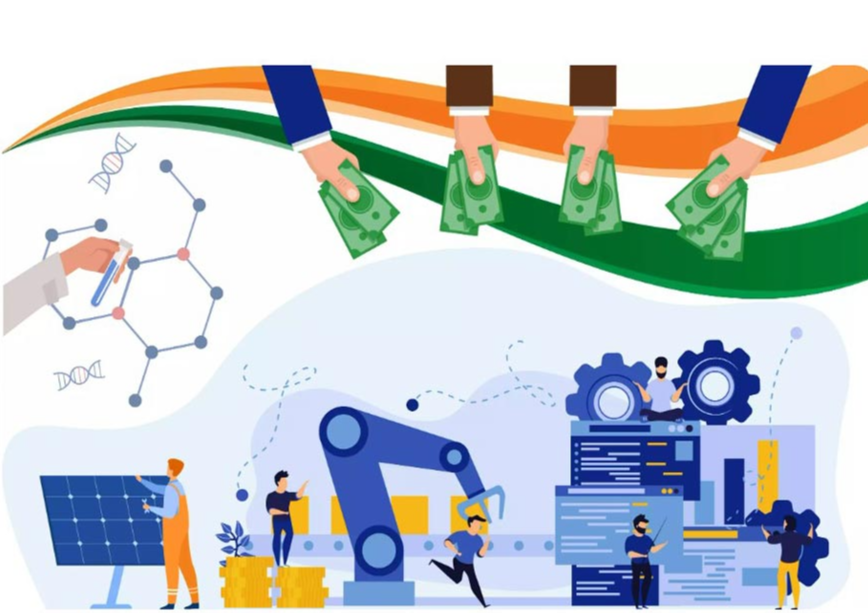
Amidst its tech wars with the United States (US), there has been a growing trend towards derisking, decoupling, and diversifying away from China, a leading country in manufacturing and exports. Its hi-tech manufacturing has decreased: in 2023, its industry rose merely by 2.7 percent—“the lowest level of growth” since 2018. A related trend is that governments worldwide are reevaluating global supply chains and aiming diversify supply chains away from China. Instead, many of them are preferring countries in South and Southeast Asia.
India, too, is capitalising on this trend by advocating self-reliance in manufacturing through its Atmanirbhar Bharat initiative. Towards this, it introduced the Production Linked Incentive (PLI) Scheme in March 2020 to serve as a strategic tool by offering incentives for companies to invest in and expand their hi-tech manufacturing capabilities. This seeks to reduce reliance on external sources and bolsters the country’s technological prowess across key sectors such as textile, agriculture, electronics goods, pharmaceuticals, and chemicals. According to the State Bank of India, in Fiscal Year 2021, imports from China amounted to INR 48.75 lakh crore, with approximately INR 3,950 crore comprising commodities and goods covered under the PLI scheme. If the scheme succeeds in decreasing dependency by 20 percent, it could contribute approximately INR 6 lakh crore to India's GDP.
Table 1: Imports from China in sectors where PLI has been announced
| Sector |
In Million US$ |
| Agriculture goods |
302 |
| Electronics |
2,3731 |
| Textiles |
2,193 |
| Chemicals |
13,599 |
| Total import from China in PLI sectors |
39,825 |
| If we reduce our dependence by 20%, addition to the GDP |
7.965 |
| If we reduce our dependence by 30%, addition to the GDP |
11,948 |
| If we reduce our dependence by 50%, addition to the GDP |
19,913 |
Source: SBI Research, CMIE
PLI scheme explained
The PLI scheme was introduced to promote domestic manufacturing in strategic sectors of the economy. Under this scheme, eligible companies receive financial incentives based on incremental production over a specified base year. These incentives encourage companies to enhance their manufacturing capabilities, invest in new technologies, and expand their production capacities, which helps create job opportunities. By linking incentives to production volumes, the PLI scheme encourages companies to scale up their operations and contribute to the country's economic growth by adding to the local supply chains.
The PLI scheme is an important step in Prime Minister Narendra Modi’s plan to make India a US$ 5-trillion economy by boosting the country’s manufacturing potential, which is expected to have additional benefits.
When introduced, the PLI scheme covered three sectors; mobile manufacturing and electric components, pharmaceutical, and medical device manufacturing. Seeing its positive impact, in August 2023, the government announced its expansion to 14 key sectors critical for India's economic growth and industrial competitiveness, with an outlay of INR 1.97 lakh crore. This indicates that the minimum production is projected to surpass INR 3.75 lakh crore within five years. The PLI scheme is an important step in Prime Minister Narendra Modi’s plan to make India a US$ 5-trillion economy by boosting the country’s manufacturing potential, which is expected to have additional benefits. Firstly, by offering financial incentives to manufacturers, the PLI scheme aims to attract domestic and foreign investment in key sectors, thereby stimulating economic growth and industrial development. Secondly, the scheme promotes export competitiveness by incentivising production for export-oriented industries. It seeks to increase India's share of global trade and reduce its dependence on imports. Finally, increased local manufacturing is also expected to increase employment in the country by creating approximately 60 lakh new jobs in the next five years.
Assessing PLI’s performance
The scheme was announced right at the start of the COVID-19 pandemic. The lockdowns, supply chain disruptions, and economic uncertainties brought about by the pandemic had a significant impact worldwide. The PLI scheme, launched initially as a response to the government’s broader strategy to boost the manufacturing sector, helped the country recover from the pandemic. However, the implementation was delayed, with most schemes mobilised in 2021-22. Given the five-year tenure for these, their full impact is yet to be assessed, however, the initial stages are looking successful. Till November 2023, the scheme has seen an investment of over INR 1.03 lakh crore, exports worth INR 3.20 lakh crore, and created over 6 lakh jobs, directly and indirectly. Beneficiaries of the scheme include Micro, Small, and Medium Enterprises (MSMEs) as well as bigger businesses, and it has significantly reduced India’s import reliance on raw materials in sectors such as pharmaceuticals. Given that electronic components manufacturing and pharmaceuticals were a part of the initial sectors, looking at their impact will be the most telling.
The PLI scheme, launched initially as a response to the government’s broader strategy to boost the manufacturing sector, helped the country recover from the pandemic.
Electronics manufacturing
Electronics manufacturing has witnessed significant growth in recent years, driven by the rise in technology and electronic devices, and the PLI scheme for electronics aims to capitalise on this momentum. Since its introduction, several major players in the electronics industry have announced plans to set up or expand their manufacturing operations in India. The manufacturing landscape in India is undergoing a profound transformation, particularly in smartphone manufacturing, semiconductor fabrication, and electronic components production. Major Apple contract manufacturers such as Foxconn, Pegatron, and Wistron have entered the fray, producing iPhones, iPads, and MacBooks within the country. This shift has also seen the establishment of semiconductor facilities, exemplified by the Vendanta-Foxconn collaboration in Gujarat, further bolstering India's foothold in large-scale electronics manufacturing. This transformation has attracted investments totalling INR 4,784 crore and has contributed to a total production value of INR 2.04 lakh crore, with exports reaching INR 80,769 crore. As of September 2022, large-scale electronics manufacturing has emerged as a standout sector, creating 28,636 jobs and driving a 139-percent increase in smartphone exports.
The allure of the PLI scheme, alongside India's expansive consumer market and skilled workforce, presents an enticing proposition for multinational corporations looking to broaden their manufacturing horizons. This confluence of factors underscores India's rise as a global manufacturing powerhouse, ushering in a new epoch of innovation and industrial advancement.
Pharmaceutical manufacturing
The pharmaceutical industry is a major beneficiary of the PLI scheme, leveraging India's prominent position as a global producer of generic drugs and vaccines. Historically, India has relied heavily on imports for critical components, leaving the pharmaceutical sector vulnerable to supply chain risks. One of the scheme's focal points is the production of active pharmaceutical ingredients (APIs) and key starting materials (KSMs). By January 2023, two projects for Bulk Drugs had been commissioned under the PLI scheme, attracting investments totalling INR 2,019 crore and employing 23,000 individuals. Since its inception, the PLI scheme has prompted numerous pharmaceutical companies to announce plans for expanding their API and KSM manufacturing capacities. For example, Rusan Pharma inaugurated a new API manufacturing facility in Madhya Pradesh, investing approximately INR 300 crore.
Companies investing in novel drug formulations, process improvements, and product quality enhancements are poised to reap the scheme's benefits.
These investments are expected to bolster India's self-reliance in pharmaceutical production and enhance the availability of domestically and globally affordable medicines. Moreover, the PLI scheme has the potential to stimulate innovation through research and development. Companies investing in novel drug formulations, process improvements, and product quality enhancements are poised to reap the scheme's benefits.
Policy to practice
India has long aspired to become a global manufacturing powerhouse, but stiff competition and structural challenges hindered its progress. The PLI scheme represents a bold step towards revitalising the country's manufacturing sector and positioning it as a global powerhouse. By incentivising production, fostering innovation, and promoting investment, it holds the potential to unleash a new wave of industrial growth and economic prosperity. As India navigates the challenges and opportunities presented by the COVID-19 pandemic, the successful implementation of the PLI scheme will be crucial in realising the country's vision of becoming a leading manufacturing hub on the world stage. Currently, challenges such as the lack of uniform criteria, ambiguity in the reward system, and the absence of a centralised database create gaps in the implementation and transparency of the program. Another issue to address is the supply chain and the cost of raw materials. For example, container manufacturing in India is more expensive compared to China because the main material, corten steel, is cheaper in China. Continued policy support, infrastructure development, and regulatory reforms will be essential to sustain and amplify the benefits of the PLI scheme in the long run.
Tanya Aggarwal is a Research Intern at the Observer Research Foundation
The views expressed above belong to the author(s). ORF research and analyses now available on Telegram! Click here to access our curated content — blogs, longforms and interviews.




 PREV
PREV


